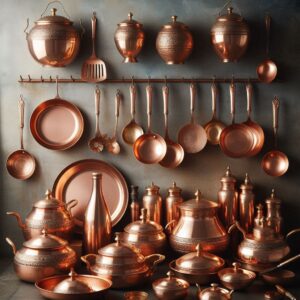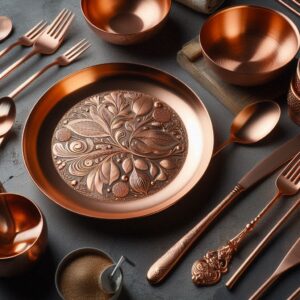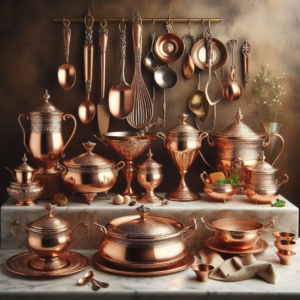Authentic Copper Products, with its timeless charm and warm, reddish-gold hue, has been a staple in home decor for centuries. Its durability and unique aesthetic appeal make it a popular choice for those looking to add a touch of elegance and sustainability to their living spaces. However, the market has seen a surge in counterfeit copper products, which not only deceive consumers but also undermine the value of genuine copper items.
The purpose of this blog is to educate readers on the significance of copper in home decor and provide them with the knowledge to identify authentic copper products. By understanding the environmental advantages, durability, and antimicrobial properties of copper, consumers can make informed decisions and appreciate the true worth of this versatile metal.
You Can Check Out Authentic and Best Copper Water Bottles Available at The Amrit Life.
In the following sections, we will delve into the importance of copper in home decor, explore the issue of counterfeit products in the market, and offer practical tips on distinguishing genuine copper items from imitations. From the color test to checking for patina, we’ll equip you with the tools to ensure the copper you bring into your home is the real deal.
The Allure of Copper in Home Decor
While There are Many Copper Water Bottle Benefits, Copper’s aesthetic appeal in home decor is undeniable. Its warm, reddish-brown hue brings a unique touch of elegance and sophistication to any space. The metal’s natural sheen and ability to develop a rich patina over time add character and depth, making each copper piece a distinct focal point in a room.
When it comes to longevity and durability, copper stands out among other materials. It’s known for its resilience, maintaining its beauty and structural integrity for decades. Copper pipes, for instance, can last anywhere from 20 to 100 years, depending on environmental factors and maintenance. This durability translates into a wise investment for homeowners seeking long-lasting decor options.
The antimicrobial properties of copper are perhaps one of its most significant health benefits. Copper surfaces have been shown to inhibit the growth of various bacteria, fungi, and viruses, contributing to a healthier living environment. This makes copper an excellent choice for kitchen and bathroom fixtures, where hygiene is paramount.
Incorporating copper into your home decor not only enhances the visual appeal but also offers practical benefits that contribute to the well-being of the household. From its stunning appearance to its health-promoting qualities, copper is a wise choice for those who value both beauty and functionality in their living spaces.
Understanding Copper Authenticity
Copper’s composition and its common alloys are fundamental to its authenticity. Pure copper is a soft, malleable, and ductile metal with high thermal and electrical conductivity. The most common copper alloys are brass, alloyed with zinc, and bronze, alloyed with tin. These alloys are created to enhance certain properties of copper, such as strength and durability.
The historical significance of copper is deeply rooted in human civilization. Dating back to 8,700 BC, copper was one of the first metals to be used by humans, marking the advent of the Copper Age. It played a crucial role in ancient societies for making jewelry, ornaments, utensils, weapons, and more.
In modern times, copper continues to be indispensable. Its applications range from electrical wiring and plumbing to the production of electronics and as a key component in renewable energy technologies like solar cells and photovoltaics.
Authenticity in copper products matters because it ensures the material’s quality, longevity, and safety. Authentic copper offers the full spectrum of its beneficial properties, including antimicrobial action and superior conductivity. Counterfeit products not only fail to provide these benefits but can also lead to health and safety risks. Therefore, understanding and ensuring the authenticity of copper products is essential for consumers and industries alike.
Visual Inspection – The First Step to Authenticity
Visual inspection is a crucial first step in verifying the authenticity of copper products. Here’s how you can perform a thorough visual check:
Color Test: True copper has a distinctive reddish-gold hue, similar to a newly minted penny. Over time, genuine copper can darken and develop a range of red, yellow, or orange tones due to oxidation1. To perform the color test, you may need to polish the item first, especially if it appears dull, to reveal the true color of the metal.
Weight and Craftsmanship: Genuine copper items typically have a substantial weight due to the density of the metal. They also often feature seamless construction with no visible joints or seams, indicating quality craftsmanship. Comparing the weight of similar items can help; if one item feels significantly heavier, it’s likely made of real copper.
Hallmarks and Stamps: Hallmarks and stamps are used to indicate the purity of the metal, the country of origin, the manufacturer, and sometimes the year it was made. Authentic copper items may have markings indicating where they were made or what company produced them, as well as the purity level of the copper, such as “99% pure”. Recognizing these hallmarks can help you determine the quality and authenticity of your copper items.
By combining these methods, you can confidently assess whether a copper product is genuine and enjoy the full benefits of this beautiful and functional metal.
Practical Tests to Confirm Copper Authenticity
To ensure you have a genuine copper item, you can perform several practical tests:
The Magnet Test: Copper is non-magnetic, which means a magnet should not stick to it. If a magnet does stick, it’s likely that the item is not pure copper or may be a different metal entirely.
The Ice Test: Copper’s high thermal conductivity means it can quickly transfer heat, making it an excellent material for pots and pans. To test this, place an ice cube on the copper item. If it’s genuine, the ice should start melting almost immediately due to the rapid heat transfer.
The Oxidation Test: Over time, copper develops a green patina when exposed to air due to oxidation. This patina is a good indicator of authenticity. You can test for this by observing any greenish areas or by applying a small amount of vinegar to a non-visible part of the item. If it’s real copper, the vinegar will cause the area to turn green.

Advanced Methods for Verifying Copper
When the basic tests are inconclusive, or when dealing with high-value copper items, it’s prudent to seek advanced methods for verification.
Professional Appraisal: Seeking expert advice is recommended when you’re dealing with antique copper items, high-value goods, or when you need a formal valuation for insurance or resale purposes. Professional appraisers have the expertise to assess the authenticity and value of copper items using a variety of techniques and their extensive knowledge of the market.
Laboratory Testing: Understanding the process and benefits of laboratory testing can provide definitive answers about the purity and composition of copper. Laboratories use sophisticated equipment to conduct tests such as spectroscopy, chemical analysis, and X-ray fluorescence (XRF), which can accurately determine the elemental makeup of the item. This method is particularly useful for manufacturers, jewelers, and consumers who require precise information about the copper they are using or purchasing.
Authentic Copper Products are these advanced methods offer a higher level of certainty and are essential tools for anyone serious about verifying the authenticity of their copper items.
Incorporating Copper into Your Eco-Friendly Lifestyle
Copper is not only aesthetically pleasing but also offers several environmental benefits that align with an eco-friendly lifestyle.
The Environmental Impact of Authentic Copper Products
Authentic copper products have a relatively low environmental impact compared to other metals. Copper is durable and has a long lifespan, which means less frequent replacement and less waste. It doesn’t break down in the environment, leading to its accumulation in plants and animals, which is essential for their health. However, copper mining and production can have adverse environmental impacts, such as soil contamination and acid rain, which the industry is working to minimize.
Recycling and Sustainability Aspects of Copper Copper is highly recyclable and can be recycled repeatedly without losing its original properties. The recycling process for copper is energy-efficient, requiring only a fraction of the energy needed to extract and process virgin copper. This contributes to a circular economy, reducing the reliance on newly mined copper and associated carbon emissions.
Making Informed Choices for a Greener Home To make your home greener, consider the sustainability of the materials you bring into it. Copper, being 100% recyclable, contributes to resource conservation and urban mining. When purchasing copper products, look for those that can be recycled and have a lower carbon footprint. Additionally, adopting simple measures such as using energy-efficient appliances and embracing renewable energy sources can further reduce your home’s environmental impact.
Conclusion
Identifying authentic copper products is essential for bringing the timeless elegance and health benefits of this noble metal into your home. By conducting thorough visual inspections, engaging in practical tests like the magnet and ice tests, and seeking advanced verification methods when necessary, you can confidently distinguish genuine copper from imitations.
Embracing copper in your home decor not only enhances its aesthetic but also contributes to a healthier and more sustainable living environment. As we strive to make eco-conscious decisions, let’s remember the importance of authenticity in copper products. It’s not just about the beauty they add to our homes, but also about the lasting value and environmental responsibility they represent.











